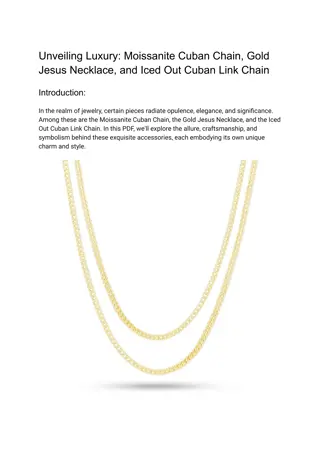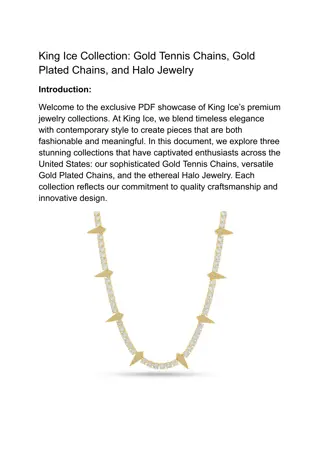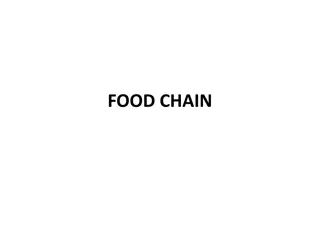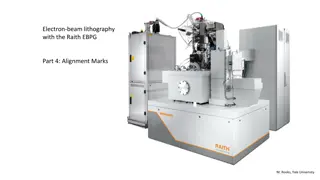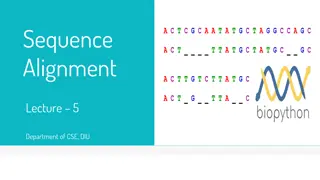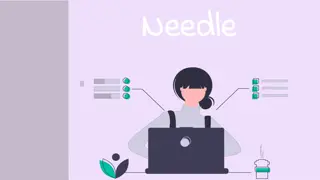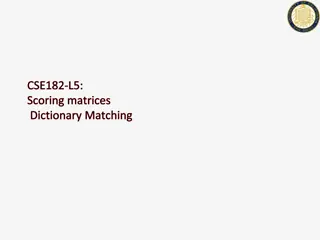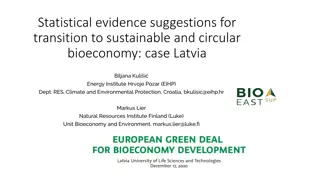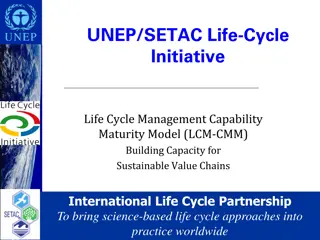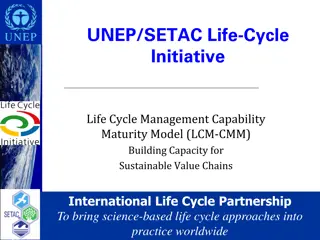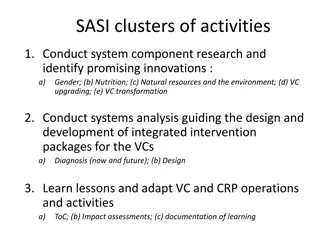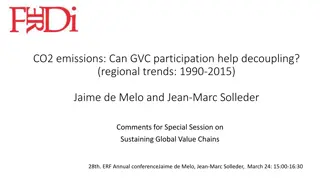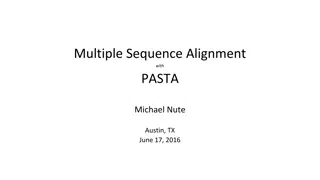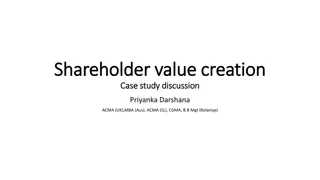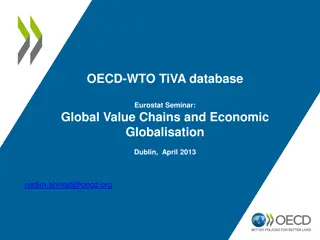Sustainable Value Chains and Business Strategy Alignment
This content covers the importance of aligning improvements with business strategy, defining company strategy, value proposition, making a business case based on external drivers impact, and building shareholder value through stakeholder management. It emphasizes the significance of adopting sustainable practices and strategic decision-making to enhance business performance and create long-term value for organizations.
Uploaded on Sep 07, 2024 | 0 Views
Download Presentation

Please find below an Image/Link to download the presentation.
The content on the website is provided AS IS for your information and personal use only. It may not be sold, licensed, or shared on other websites without obtaining consent from the author.If you encounter any issues during the download, it is possible that the publisher has removed the file from their server.
You are allowed to download the files provided on this website for personal or commercial use, subject to the condition that they are used lawfully. All files are the property of their respective owners.
The content on the website is provided AS IS for your information and personal use only. It may not be sold, licensed, or shared on other websites without obtaining consent from the author.
E N D
Presentation Transcript
UNEP/SETAC Life-Cycle Initiative Life Cycle Management Capability Maturity Model (LCM-CMM) Building Capacity for Sustainable Value Chains International Life Cycle Partnership To bring science-based life cycle approaches into practice worldwide
ALIGNING IMPROVEMENTS WITH BUSINESS STRATEGY
WHAT IS COMPANY STRATEGY? Vision - why the organization exists, the market need it will provide. Mission - what the organization is going to do to achieve vision, kinds of activities. Strategy howit will undertake mission to achieve advantage over competitors by either doing different activities or doing similar activities differently Source: Collis, D. J., & Rukstad, M. G. (2008). Can you say what your strategy is? Harvard Business Review, 86(4), 82-90.
VALUE PROPOSITION Defines Benefit the company will provide To which market segments And how the company s offering will be uniquely superior to offerings of competitors What attributes does customer use to evaluate competitive offerings?
MAKING A BUSINESS CASE EXTERNAL DRIVERS IMPACT ON COMPANY CAPTURING VALUE Products / Customers New products & services, brand value Market restrictions Taxes- e.g. carbon tax Factories/ Communities License to operate, ease of permitting Improved process efficiency Employee morale, productivity Taxes, fines, liabilities Supply Chain Public campaigns, supply interruptions Liability for clean up Access to quality suppliers Public/ Communications Access to capital Recruitment & retention Reputation, brand value, stock P/E ratio Economic Income inequality Outsourcing jobs Trade imbalances Environmental Climate change- extreme weather, rising sea, 90 F days, crop damage Peak oil, price volatility Air quality- respiratory illness, asthma Resource depletion- e.g. rare earths Toxic chemicals Water scarcity, quality Land use Biodiversity & species extinctions Social Child, forced labor Supply chain mgmt in developing economies Socially responsible investors Fair trade Revenue Margin Cost of Sales ROIC Working Capital Invested Capital Fixed Capital
BUILD SHAREOWNER VALUE Stakeholder Potential Sources of Shareowner Value Investors Access to socially responsible investor capital; potentially lower weighted average cost of capital (WACC) Employees Hiring and retention of talent; Improved employee morale and productivity Customers Brand loyalty and reputation; goodwill and intangible value; collaboration in developing new products Business partners Access to strategic resources and capabilities Unions Improved labor relations and conflict resolution Value chain associates Cost- reduction/ value enhancing collaboration throughout the value chain Regulatory authorities Validation of specific product/ service quality levels; lobbying regulations in company s favor; increased flexibility with regulators Governments Favorable fiscal and industry- specific environmental and social policies Local communities and citizens Mutual support and accommodation; license to operate ; reasonable treatment with respect to local taxes and service fees Non- governmental organizations (NGO) Constructive collaboration with individual organizations and groups; favorable public opinion environment; license to operate
PORTERS FIVE FORCES Potential Entrants Threat of new entrants Bargaining power of suppliers Industry Rivalry among existing firms Buyers Suppliers Bargaining power of buyers Threat of substitute products Substitutes Michael E. Porter. "The Five Competitive Forces that Shape Strategy", Harvard Business Review, January 2008, p.86-104
VALUE CHAIN ANALYSIS A C T I V I T I E S Procurement S U P P O R T Human Resource Management Technology Development Procurement Primary Activities Framework for identifying or developing distinct competencies Porter, Michael E. Competitive advantage: Creating and sustaining superior performance. Simon and Schuster, 2008.
STRATEGY & SOCIETY Firm strategy, structure, and rivalry Factor Conditions Demand Conditions Related and Supporting Industries Porter, M. E. & Kramer, M.R (2006). Strategy & Society: The Link Between Competitive Advantage and Corporate Social Responsibility. Harvard Business Review, December, 78- 92.
COMPETING FOR THE FUTURE What is the basic value proposition? How have we segmented the market? What kind of customers do we serve? Where are our customers? What customers and needs are we NOT serving? CONCEPT OF SERVED MARKET Where in business system do we make profit? Where do margins come from? What has determined size of margins? What are major cost & price drivers? Could profits be extracted at a DIFFERENT POINT in the value chain? REVENUE AND MARGIN STRUCTURE Might customers needs be better served by an ALTERNATE CONFIGURATION of skills and assets? What do we believe we know how to do well? What physical infrastructure supports us? What kind of skills predominate in our company? What is the trajectory of our development spend? CONFIGURATION OF SKILLS AND ASSETS How alert are we to new value delivery models? How easily could investment programs be re- oriented? How easily could the infrastructure be changed? Which constituencies would most resist change? What is our VULNERABILITY to the new rules of the game ? FLEXIBILITY & ADAPTIVENESS Hamel, G. & Prahalad, C.K. (1994). Competing for the future. Harvard Business School Press. Boston, MA
MATURITY ASSESSMENT Fix Gaps Build Key Strengths
PROJECT ALIGNMENT Value Proposition Brief description identifying attributes customer uses to evaluate alternative products that are relevant to project ( or relevant internal goals) Key Activities Project Description Financial Outcomes Key activities & skills for successful implementation of strategy that will be addressed by the project Near term performance objectives for the project with attention to how these align with value proposition Description of activities to implement project with attention to how these align with key activities & resources Key Resources Organizational systems and structures addressed by project & critical to success Environmental Outcomes Near term non financial benefits of project
EXAMPLE Project #2 Install heat recovery on wash line Value Proposition Will support customer desire for reliable, cost effective suppliers; supprt eco- label requirements Key Activities Project Description Financial Outcomes Project analysis; procedures for collecting, quality assurance of process data Direct cost savings; <3 year payback Install equipment to improve energy efficiency, may help reduce water consumption Project will also develop outline for formal energy mgmt. system; develop data systems for eco- labels Key Resources $ for capital equipment Training for financial analysis of projects Environmental Outcomes Reduced fuel consumption; GHG reductions
WORKSHEET #9 -Project Alignment Value Proposition Key Activities Project Description Financial Outcomes Key Resources Environmental Outcomes


